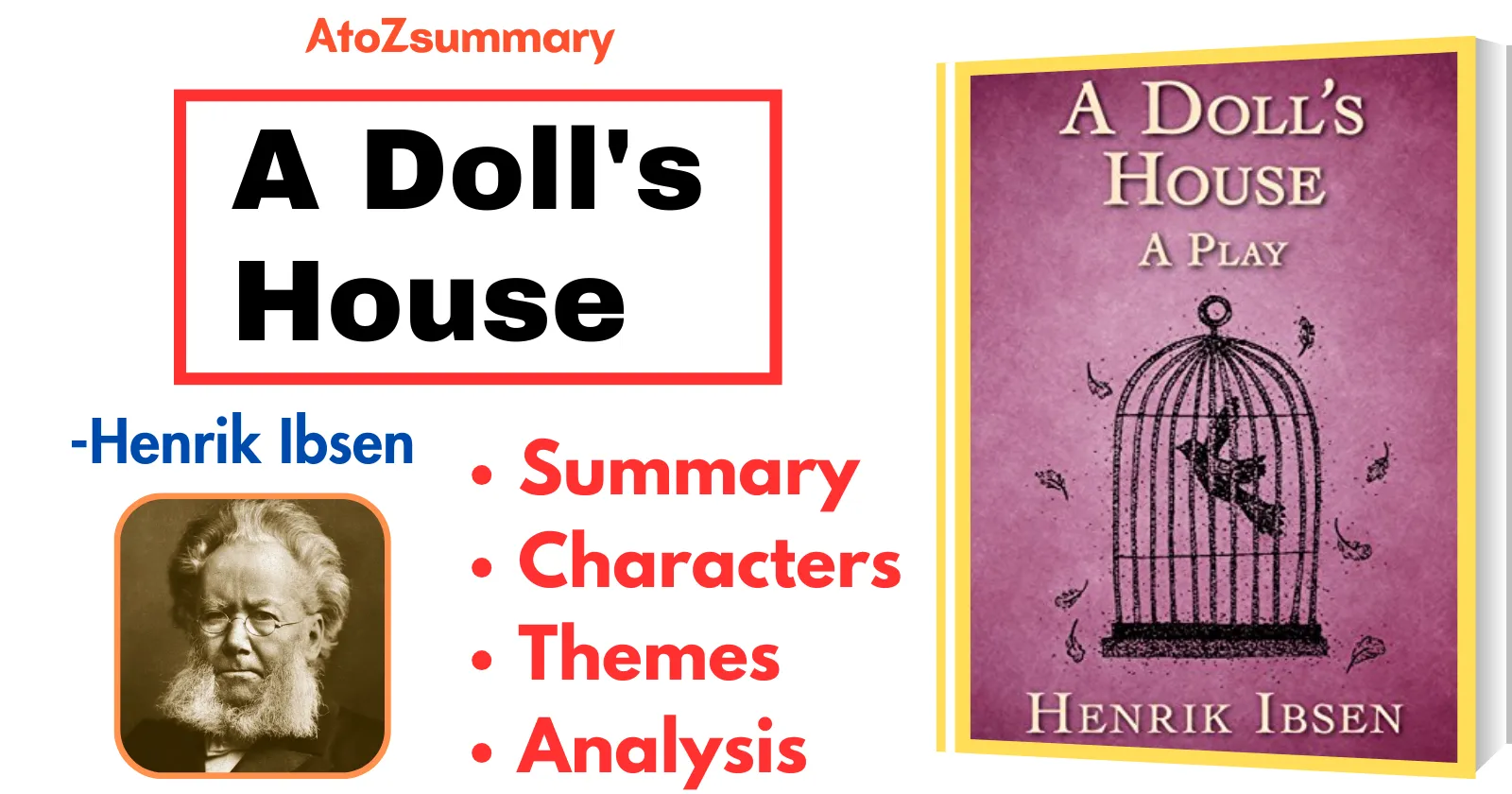About the Play: A Doll’s House
| Title | A Doll’s House |
|---|---|
| Author | Henrik Ibsen |
| Genre | Social Drama |
| Premiere | February 23, 1879 |
| Setting | 19th-century Norway |
| Structure | Three Acts |
| Narration | Third-Person |
| Tone | Serious, Dramatic |
| Style | Realistic, Naturalistic |
| Language | Norwegian |
| Symbolism | Christmas tree, tarantella costume, macaroons |
| Major Conflicts | Nora’s struggle to reconcile her own desires with societal expectations, Nora’s conflict with her husband Torvald, Nora’s moral dilemma |
| Legacy | Continues to be performed and studied today for its exploration of gender roles and social norms |
Analysis: A Doll’s House
“A Doll’s House” by Henrik Ibsen is a play that explores the social expectations and constraints on individuals, particularly women, in the 19th century. The main character, Nora, is a housewife who seems happy but is secretly dealing with financial troubles. As the play progresses, Nora’s realization of her own worth and desire for personal freedom lead to a dramatic climax. The play challenges traditional gender roles and exposes the superficiality of societal norms. It’s a powerful commentary on individuality, societal expectations, and the consequences of challenging established norms.
Characters: A Doll’s House
The characters of “A Doll’s House” by are:
- Nora Helmer: The protagonist, a cheerful and somewhat naive wife who becomes aware of her stifling marriage and seeks independence.
- Torvald Helmer: Nora’s husband, a banker who initially appears loving but reveals a condescending attitude towards his wife.
- Mrs. Kristine Linde: Nora’s old friend, a practical and mature woman who faces financial challenges.
- Nils Krogstad: A disgraced employee at Torvald’s bank, he plays a crucial role in the unfolding drama.
- Dr. Rank: Torvald’s friend and a family confidant, he is suffering from a terminal illness.
- The Children (Ivar, Bob, and Emmy): Nora and Torvald’s children, who are often mentioned but have a limited presence in the play.
Themes: A Doll’s House
The themes of “A Doll’s House” by are:
- Women’s Rights: The play explores the limited rights and expectations imposed on women in the 19th century.
- Gender Roles: It challenges traditional gender roles, depicting the struggles of women who are expected to conform to societal norms.
- Individual Freedom: Nora’s journey highlights the importance of individual freedom and self-discovery.
- Deception and Secrecy: The play delves into the consequences of deception and the impact of keeping secrets in relationships.
- Social Expectations: It examines societal expectations and the pressure to conform, especially in the context of marriage and family.
- Independence: Nora’s pursuit of independence underscores the theme of personal autonomy and the desire for a life beyond societal expectations.
- Critique of Marriage: The play critiques conventional notions of marriage, revealing the strains and expectations placed on couples.
- Financial Dependency: Financial dependence is explored through Nora’s situation, highlighting the challenges and power dynamics associated with economic reliance on a spouse.
Watch Full Play Summary of “A Doll’s House”
Summary of “A Doll’s House” by Henrik Ibsen
The play opens on Christmas Eve, A Doll’s House. Entering her well-decorated living room, which serves as the play’s backdrop, Nora Helmer is holding many packages. When he hears her arriving, Nora’s husband, Torvald Helmer, emerges from his study. Playful and kind, he greets her but chastises her for spending so much money on Christmas presents. The Helmers have had to be frugal with their money for a long time, but their talk indicates that Torvald recently got a new job at the bank where he works, which will allow them to live a more comfortable lifestyle.
The maid Helene informs everyone that Dr. Rank, a close friend of the Helmers, is visiting them. Simultaneously, another guest has arrived, who is yet to be identified. Kristine Linde, an old school buddy, enters the room much to Nora’s dismay. Although the two haven’t seen one another in years, Nora says she’s heard that Mrs. Linde’s husband died a few years ago. Mrs. Linde informs Nora that she was left childless and penniless when her husband passed away. About her first year of marriage to Torvald, Nora shares with Mrs. Linde. She recalls that they both had to work long hours and were quite impoverished. She continues, “Torvald was ill, and the pair had to go to Italy so that Torvald could recover.
When Nora asks more about Mrs. Linde’s background, she reveals that she had to take care of her two younger brothers and her ailing mother for several years. However, she claims that her mother has died away and that the boys are grown enough to not require her. Mrs. Linde claims that, rather than being relieved, she feels empty since she is unemployed; she thinks that Torvald may be able to assist her in finding work. Following her pledge to talk with Torvald, Nora divulges to Mrs. Linde a most important secret: she unlawfully stole money for the vacation she and Torvald went to Italy, telling Torvald it was from her father. Nora discloses that she has been working and saving covertly for years, gradually paying off the debt, which will soon be settled in full.
Arriving at the bank where Torvald works, Krogstad, a low-level employee, enters Torvald’s study. Krogstad’s presence causes Nora to respond uncomfortably, and Dr. Rank declares Krogstad to be “morally sick” after the research. Torvald enters the living room after his discussion with Krogstad and remarks that he can most likely recruit Mrs. Linde at the bank. Then, Mrs. Linde, Dr. Rank, and Torvald leave, leaving Nora alone. When Nora’s kids and their babysitter, Anne-Marie, return, she plays with them until she realizes that Krogstad is in the room. During their conversation, Krogstad is identified as the one who gave Nora the covert loan.
Krogstad mentions his bad reputation while claiming that Torvald wants to remove him from his bank job. He asks Nora to make use of her connections to keep his job safe. Krogstad reminds her that he has a document that has Nora’s forgery of her father’s signature on it when she refuses. Blackmailing Nora, Krogstad threatens to expose her transgression and to bring shame and dishonor upon her and her husband should she fail to stop Torvald from terminating him. After Krogstad leaves, Nora attempts to persuade Torvald not to dismiss Krogstad when he returns, but Torvald is unreceptive. He calls Krogstad an unethical man and says being around such individuals makes him physically sick.
Act Two begins on Christmas Day, the next day. Feeling anxious, Nora paces her living room by herself. When Mrs. Linde shows up there, she offers to assist with sewing Nora’s costume for the ball the next evening at her neighbor’s house. Dr. Rank has a fatal condition that he got from his father, Nora informs Mrs. Linde. Mrs. Linde surmises that Dr. Rank is Nora’s lender based on her suspicious conduct. Although Nora declines to address Mrs. Linde’s accusation, she won’t say what is causing her worry. When Torvald gets there, Nora begs him once more to keep Krogstad working at the bank, but Torvald declines. When Nora confronts him, he confesses that he is more offended by Krogstad’s too-familiar demeanor than by his moral actions. Before Sending the Maid to Deliver Krogstad’s Letter of Dismissal, Torvald and Nora quarrel.
Torvald walks off. When Dr. Rank shows up there, he informs Nora that he is aware of his impending death. She starts to flirt with him to lift his spirits. She seemed to be getting ready to ask him to step in and help her during her conflict with Torvald. Dr. Rank abruptly confesses to Nora his love for her. After learning this, Nora declines to make any more requests of Dr. Rank.
When Dr. Rank departs, Krogstad shows in and demands to know why he was fired. In an attempt to gain a reputation, he has modified the conditions of the blackmail, demanding to be rehired not just at the bank but also in a more senior position. He then inserts a letter into the Helmers’ letterbox, outlining Nora’s debt and forgeries.
Mrs. Linde receives a panicked update from Nora, telling her to keep Torvald from seeing the letter for as long as possible while she runs to talk to Krogstad. Nora starts to rehearse the tarantella she will be performing at the costume party that evening in an attempt to divert Torvald’s attention away from the mailbox. She dances wildly and aggressively in her aroused emotional state, which annoys Torvald. Torvald is persuaded by Nora to wait to check his mail until after she performs at the party. Soon after, Mrs. Linde reappears and informs Krogstad that she has left a letter but that he won’t be back until the next evening.
In the ending of “A Doll’s House,” Nora realizes that she has been living a confined and artificial life, shaped by societal expectations. She decides to leave her husband, Torvald, and children to discover her own identity and pursue personal freedom. The slamming of the front door in the final scene symbolizes Nora’s bold departure from her conventional role and signifies a groundbreaking act of self-liberation. The play ends with Nora choosing independence over societal norms, sparking discussions about gender roles and societal expectations.
FAQs
What is the story a doll’s house about?
What is the main message of a doll’s house?
“A Doll’s House” challenges societal expectations and emphasizes the importance of self-discovery and freedom for women.
Is a doll house based on a true story?
Yes, A Doll’s House is loosely based on the life of Laura Kieler, a friend of Ibsen who forged a check to save her husband’s life.
What mistake did Nora make when she got the loan?
In A Doll’s House, Nora secretly forged her father’s signature to obtain a loan to save her husband’s life, an act that would have severe consequences for her.
What crime has Nora committed?
Nora forges her father’s signature on a loan document to save her husband’s life.
What is the irony in a doll’s house?
Nora, perceived as a submissive housewife, ultimately breaks free from societal expectations and chooses her own path.
What does Nora lie to Torvald about?
Nora lies to Torvald about borrowing money from Krogstad to save his life.
Is Torvald in love with Nora?
Torvald’s love for Nora is superficial and self-serving, as he values her more as a possession than as an individual.
Why does Nora realize she never loved Torvald?
Nora realizes she never loved Torvald when she sees his true character as he prioritizes his reputation over her well-being.
Who is the villain in a doll’s house?
Nils Krogstad is the main villain in the play “A Doll’s House” by Henrik Ibsen.
What is the foreshadowing in the Doll’s House?
The foreshadowing in “A Doll’s House” hints that Nora’s seemingly happy life may have underlying problems, especially regarding money.
What is Krogstad’s secret?
Krogstad’s secret is that his signature was forged on a document to obtain a loan for Nora.
What happened at the end of a doll’s house?
After realizing her true self-worth and the limitations imposed by societal expectations, Nora Helmer makes the shocking decision to leave her husband and children to pursue her own independence.








![Regretting You Summary, Themes, Synopsis & Characters [Book by Colleen Hoover] Regretting You Summary, Themes, Synopsis & Characters [Book by Colleen Hoover]](https://atozsummary.com/wp-content/uploads/2023/05/Regretting-You-Summary-Themes-Synopsis-Characters-Book-by-Colleen-Hoover-1024x576.webp)

![Juliet Takes a Breath Summary, Themes, Synopsis & Characters [Novel by Gabby Rivera] Juliet Takes a Breath Summary, Themes, Synopsis & Characters [Novel by Gabby Rivera]](https://atozsummary.com/wp-content/uploads/2023/05/Juliet-Takes-a-Breath-Summary-Themes-Synopsis-Characters-Novel-by-Gabby-Rivera.webp)
